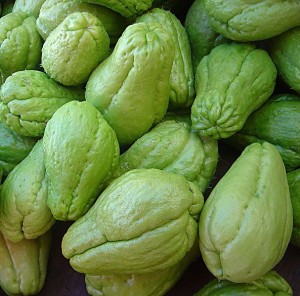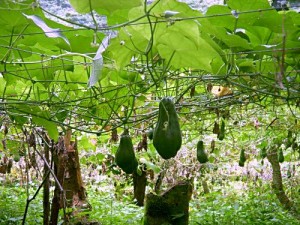 Chayote (Sechium edule) popularly known as Sayote in the Philippines, is an edible plant that belongs to the gourd family Cucurbitaceae along with melons, cucumbers and squash. The fruits are pear shaped with thin green wrinkly skin and white flesh, ranging from 10 to 20 cm in length. The flesh has a fairly bland taste, and a texture described as a cross between a potato and a cucumber. It can be eaten raw, cooked, mashed, baked, boiled, fried, or even pickled. The root, stem, seeds, and leaves of the plant are all edible. Chayote is a good source of amino acids and high in fiber, potassium, calcium, iron, and vitamin C.
Chayote (Sechium edule) popularly known as Sayote in the Philippines, is an edible plant that belongs to the gourd family Cucurbitaceae along with melons, cucumbers and squash. The fruits are pear shaped with thin green wrinkly skin and white flesh, ranging from 10 to 20 cm in length. The flesh has a fairly bland taste, and a texture described as a cross between a potato and a cucumber. It can be eaten raw, cooked, mashed, baked, boiled, fried, or even pickled. The root, stem, seeds, and leaves of the plant are all edible. Chayote is a good source of amino acids and high in fiber, potassium, calcium, iron, and vitamin C.
Chayote vine can be grown on the ground, but it is a climbing plant that will grow onto anything and can easily rise as high as 12 meters when it can reach a tree or house. Its leaves are heart-shaped, 10–25 cm wide and with tendrils on the stem. The flowers are cream-colored or somewhat green that come out beneath a leaf or branch. If the plant is male, the flowers will show in clusters. The plant’s fruit is light green and elongated with deep ridges lengthwise.
Production of Chayote or Sayote
Climatic Responses
Chayote can be grown in the tropics and subtropics from sea-level to 6000 feet above sea-level. The crop is very sensitive to frost. Optimum conditions for growth and fruiting are 30C daytime and 15C nighttime temperatures. It requires 12 to 12.5 hr daylength for flowering. The plant can grow under full sun to mild shaded conditions. Fruits exposed to full sun are light yellow, while shadegrown plants produce darker green fruit.
Culture and Management
Soil
Chayote prefers rich, well-drained soil. It can not withstand waterlogging. In wet high rainfall areas it is planted in raised hills or mounds. Good preparation of the planting hole is important. Work the soil 2 feet deep and 3 feet in diameter. Addition of organic matter will improve drainage and nutrient uptake.
Propagation and Planting
Propagation is by planting the entire fruit. Young basal shoot cuttings are also sometimes used. Place the fruit at a 45 degree angle
with the shoot downward and the narrow stem-end base slightly protruding from the soil line. Deep planting will lead to fruit rot. Space plants 7-11 feet apart. Some growers use a 12 x 12 field spacing. The trellis is about 6 feet tall and needs to be solid to support the prolific growing vines. In home-gardens the plants can be trained to grow on trees or fences. In areas with no irrigation, the crop is planted at the beginning of the rainy season. Planting material (whole fruits) are normally available locally from fellow gardeners or growers.
Irrigation
Chayote needs ample soil moisture for good growth. Irrigation is necessary during dry spells in the growing cycle. Do not allow the soil to waterlog, however. Sprinkler irrigation may disrupt bee activity during pollination resulting in flower abscission.
Fertilization
In the homegarden chayote requires little nitrogen but fruit yields do respond to potassium fertilization. Excessive nitrogen applications may promote vine growth at the expense of fruit yields. Excessive nitrogen may also result in flower abscission. Under commercial conditions rates between 300-500 lbs/acre of N are required to attain maximum yields. For maximum yields the N is applied every two months at two application points 5 inches deep at a 5 inch distance from the plant, plus 50 lb/acre of P2O5 applied all at planting, and 50 lbs/acre of K2O applied half at planting, and the second half six months after planting. In a 200 day growing season, chayote was found to absorb most nitrogen and phosphorus between 105 and 135 days after planting, and to absorb most potassium between 150 and 165 days after planting. In the 200 growth cycle chayote removed 48 lbs of N; 9.5 lbs of phosphorus, and 10 lbs of calcium on a per acre basis.

Harvest
The vines flower in 3-5 months and the fruits are ready for harvest 28-32 days after pollination. Under commercial conditions the fruit is picked two or three times weekly when slightly immature, just before the seed protrudes from the apex. Yields vary from 75-600 fruit per vine which amount to 50,000 fruit per acre in commercial fields (60-100,000 lbs/acre). Yields often decline after the third year. To control growth habit and for ease of harvest, vines may be trimmed after each harvest.
Postharvest handling
Fruits must be harvested and handled carefully to prevent cuts, bruises, and spread of diseases. It is normally pre-cooled in cold rooms or through forced air. In the market, it is packaged in fiberboard boxes with dividers, each piece in a film bag, single layer, 24-30 count for 20 lbs per box. The boxes are hand-loaded or unitized on pallets. During handling the fruits are sensitive to chilling at 41F (5C), to moisture loss, and are sensitive to ethylene. Chilling injury results in swollen, watery looking spots formed on the periderm. Chayote can be stored for 4-6 weeks at 45F and 85-90 RH. Sprouting is promoted at 78F (25C).
Pests and Diseases
Diseases and insects are similar to those affecting squash and pumpkin. Roots of chayote are susceptible to the nematode Heterodera radicicola. The melon fly causes blemishes, but do not develop on the fruit. Other insect pests include cucumber beetle, squash ladybug, and the squash vine borer. Early downy mildew attacks often kills chayote before reaching maturity. Common diseases in the tropics include Mycovellosiela cucurbiticola, and Ascochyta phaseolorum. These diseases are common during the rainy season and persist until harvest. High disease incidence of Mycovellosiela and Ascochyta have also been observed in fields receiving high nitrogen fertilization rates.
Source: Hector Valenzuela; Photos: wikipedia.com and kelsielita.com